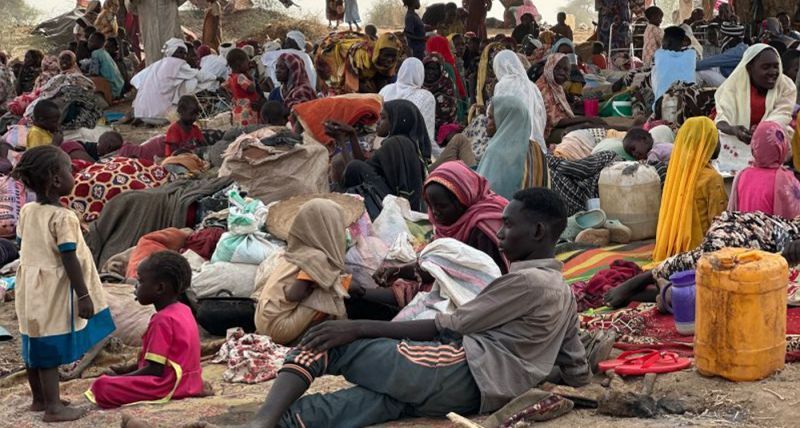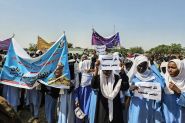- Home
- Middle East
- Sudan: What You Need to Know After Two Years of Hell

People who fled the Zamzam IDP camp after it fell under the control of the RSF rest in a makeshift camp in a field near the town of Tawila in Sudan's war-torn West Darfur region, on April 13, 2025. ©AFP
Since April 15, 2023, Sudan has been ravaged by a brutal civil war between the country’s two main armed forces: the regular army, led by General Abdel Fattah al-Burhan, and the Rapid Support Forces (RSF), a paramilitary militia commanded by General Mohamed Hamdan Dagalo, better known as Hemedti. The conflict, which erupted in the heart of the capital Khartoum, quickly spread across the country, plunging Sudan into a spiral of violence, mass displacement and state collapse.
A Failed Transition
The roots of the war lie in the failed political transition following the ousting of Omar al-Bashir. Overthrown in April 2019 after three decades of dictatorship, Bashir left behind a militarized state, deeply fragmented and lacking solid democratic institutions.
Initially, Burhan and Hemedti positioned themselves as guarantors of the transition, forming a Sovereign Council tasked with transferring power to civilians. However, tensions quickly emerged between the two generals, particularly over the crucial issue of integrating the RSF into the national armed forces – a move Hemedti perceived as a direct threat to his autonomous power.
Hostilities broke out in April 2023, after months of provocations and troop movements. Khartoum rapidly became a battlefield. The RSF, better equipped for urban combat and backed by agile logistics, entrenched themselves in residential areas and seized numerous strategic buildings. The army responded with massive airstrikes, resulting in heavy civilian casualties. The capital quickly became uninhabitable. Millions fled the fighting, basic services collapsed, and looting became rampant.
The Horrors of Darfur
The conflict then spilled into Darfur, where the RSF has deep roots. In fact, the RSF originated from the infamous Janjaweed militias – Arab tribal fighters used by the Bashir regime – notorious for the massacres they committed in the region during the 2000s.
In Darfur, the war took an even more horrific turn, with episodes of ethnic cleansing, particularly targeting the non-Arab Masalit population in the west. Testimonies and NGO reports describe mass executions, systematic rape, and entire villages razed to the ground. Already devastated, Darfur once again became one of the epicenters of human suffering in the 21st century.
The humanitarian impact is enormous. The UN High Commissioner for Refugees estimates that over 13 million people have been displaced since the war began – either within Sudan or to neighboring countries such as Chad, South Sudan and Ethiopia. More than 14,000 deaths have been documented, but the real numbers are likely much higher. Hospitals no longer function, food distribution networks are paralyzed, and famine threatens more than 18 million people.
Sudan is now the site of the world’s largest displacement crisis, surpassing even Syria at the height of its civil war or Ukraine, in terms of the proportion of population affected.
Who Is Winning?
Two years into the civil war, the military situation in Sudan remains complex and fluid. In March 2025, the Sudanese army recaptured Khartoum, marking a significant strategic victory. It also advanced in Omdurman – Sudan’s largest city, located across the Nile from the capital – and consolidated its hold on the country’s central region.
However, the RSF still maintains a dominant presence in Darfur, controlling four of the region’s five states. It has intensified its offensives, notably by besieging the provincial capital al-Fasher and taking over the Zamzam displacement camp, triggering the flight of hundreds of thousands.
Foreign Interests Behind the Scenes
Diplomatically, the war in Sudan is far from a purely internal conflict. It has become a battleground for competing geopolitical interests. General Burhan is actively supported by Egypt, which views him as a strategic ally for managing migration flows, combating Islamism, and addressing Nile River disputes with Ethiopia. Chad also has a complicated relationship with Burhan, though its support is limited and sometimes contradictory.
Hemedti, meanwhile, receives substantial financial and military backing from the United Arab Emirates. According to an investigation by The Guardian, Abu Dhabi supplies him with weapons and equipment via Libya’s Benghazi port, controlled by his ally, Field Marshal Khalifa Haftar.
In return, the UAE has tightened its grip on Sudan’s gold mines, which are under RSF control. A report by US-based investigative organization The Sentry also indicates that the Wagner Group – Russia’s informal military arm in Africa – has provided the RSF with military equipment, notably through the Central African Republic, where Wagner has a strong presence. Moscow sees Hemedti as a medium to expand its influence in the Sahel region and secure mining interests, especially in gold.
Western powers, for their part, have been largely outpaced by the speed of the conflict. The United States, which played an active role in the post-2019 transition, attempted several mediations, particularly through negotiations in Jeddah with Saudi Arabian support. However, these talks have yielded no lasting results.
The UN, African Union and the Intergovernmental Authority on Development – a regional bloc – have all struggled to impose a viable roadmap, as both sides refuse to relinquish power.
A Bleak Future
As the conflict enters its third year, there is no prospect for peace in sight. Frontlines shift, alliances evolve, but the population continues to pay the highest price. Sudanese society is crumbling, young people are fleeing en masse, and ethnic minorities are being targeted.
Sudan, the second-largest country in Africa, has become a ghost state – devoid of institutions, fragmented by militias, and governed by the logic of war.
Read more




Comments